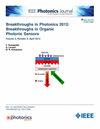启用化学全息术:一个全面的框架和实施
IF 2.4
4区 工程技术
Q3 ENGINEERING, ELECTRICAL & ELECTRONIC
引用次数: 0
摘要
中红外光谱成像(MIRSI)能够实现分子的空间分辨识别,并广泛应用于从生物医学诊断到法医等领域。目前的MIRSI技术测量样品的消光系数,这只是复杂相对介电常数的一个组成部分,因此提供不完整的分子谱。我们提出了一种新的框架和仪器,使相敏化学全息术能够在任何波长下测量样品的复杂分子特性,从而克服了分子特异性的基本限制。将空间相干量子级联激光器(QCL)光源与干涉仪和成像系统相结合,可以为分子分析提供相敏平台。本文描述了化学全息术的理论框架,并展示了分子特异性、改进的空间分辨率和更大的灵活性的好处。采用深度学习方法求解化学非均质样品的逆散射问题。此外,我们展示了新的,定制的仪器和实验结果,验证了我们的理论框架。本文章由计算机程序翻译,如有差异,请以英文原文为准。
Enabling Chemical Holography: A Comprehensive Framework and Implementation
Mid-infrared spectroscopic imaging (MIRSI) enables the spatially-resolved identification of molecules and is widely used in fields ranging from biomedical diagnostics to forensics. Current MIRSI technologies measure the sample's extinction coefficient, which is only one component of the complex relative permittivity, and therefore provide incomplete molecular profiles. We propose a new framework and instrument to enable phase-sensitive chemical holography that measures a sample's complex molecular properties at any wavelength, thus overcoming a fundamental limit on molecular specificity. Combining a spatially coherent quantum cascade laser (QCL) source with an interferometer and imaging system can provide a phase-sensitive platform for molecular analysis. This paper describes a theoretical framework for chemical holography and demonstrates benefits for molecular specificity, improved spatial resolution, and greater flexibility. Deep learning is used to solve the inverse scattering problem for chemically heterogeneous samples modeled using Mie theory. Furthermore, we demonstrate new, custom-built instrumentation and experimental results that validate our theoretical framework.
求助全文
通过发布文献求助,成功后即可免费获取论文全文。
去求助
来源期刊

IEEE Photonics Journal
ENGINEERING, ELECTRICAL & ELECTRONIC-OPTICS
CiteScore
4.50
自引率
8.30%
发文量
489
审稿时长
1.4 months
期刊介绍:
Breakthroughs in the generation of light and in its control and utilization have given rise to the field of Photonics, a rapidly expanding area of science and technology with major technological and economic impact. Photonics integrates quantum electronics and optics to accelerate progress in the generation of novel photon sources and in their utilization in emerging applications at the micro and nano scales spanning from the far-infrared/THz to the x-ray region of the electromagnetic spectrum. IEEE Photonics Journal is an online-only journal dedicated to the rapid disclosure of top-quality peer-reviewed research at the forefront of all areas of photonics. Contributions addressing issues ranging from fundamental understanding to emerging technologies and applications are within the scope of the Journal. The Journal includes topics in: Photon sources from far infrared to X-rays, Photonics materials and engineered photonic structures, Integrated optics and optoelectronic, Ultrafast, attosecond, high field and short wavelength photonics, Biophotonics, including DNA photonics, Nanophotonics, Magnetophotonics, Fundamentals of light propagation and interaction; nonlinear effects, Optical data storage, Fiber optics and optical communications devices, systems, and technologies, Micro Opto Electro Mechanical Systems (MOEMS), Microwave photonics, Optical Sensors.
 求助内容:
求助内容: 应助结果提醒方式:
应助结果提醒方式:


